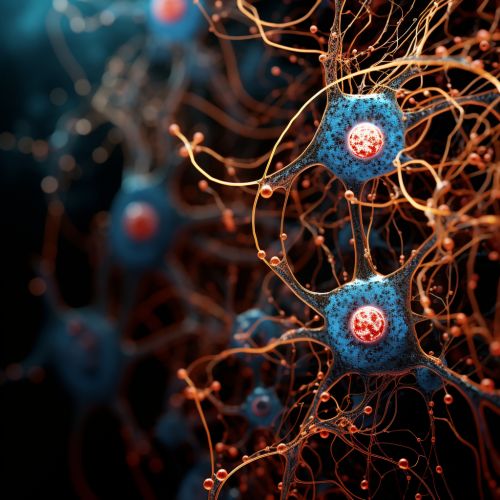Synapse
Introduction
A synapse is a specialized junction through which neurons signal to each other and to non-neuronal cells such as those in muscles or glands. Synapses are crucial to the biological computations that underlie perception and thought. They also provide the means through which the nervous system connects to and controls the other systems of the body.
Structure and Function


The structure of a synapse consists of the presynaptic terminal, or bouton, of one neuron, the postsynaptic terminal of another neuron, and the synaptic cleft between them. The presynaptic terminal contains synaptic vesicles filled with neurotransmitter molecules. The postsynaptic terminal contains receptors for these neurotransmitters. When an action potential reaches the presynaptic terminal, it triggers the release of neurotransmitter into the synaptic cleft. The neurotransmitter diffuses across the synaptic cleft and binds to receptors on the postsynaptic terminal, triggering a response in the postsynaptic neuron.
Types of Synapses
There are two main types of synapses: chemical synapses and electrical synapses. In a chemical synapse, the presynaptic and postsynaptic neurons are separated by a small gap called a synaptic cleft. In an electrical synapse, the presynaptic and postsynaptic neurons are connected by gap junctions, allowing ions and small molecules to flow directly from one neuron to the other.
Chemical Synapses
Chemical synapses are the most common type of synapse in the human brain. They use neurotransmitters to transmit signals from the presynaptic neuron to the postsynaptic neuron. The process of neurotransmission begins when an action potential reaches the presynaptic terminal, causing voltage-gated calcium channels to open. Calcium ions flow into the cell, triggering the release of neurotransmitter from synaptic vesicles into the synaptic cleft. The neurotransmitter diffuses across the synaptic cleft and binds to receptors on the postsynaptic terminal, triggering a response in the postsynaptic neuron.
Electrical Synapses
Electrical synapses are less common than chemical synapses, but they play important roles in certain types of neural circuits. In an electrical synapse, the presynaptic and postsynaptic neurons are connected by gap junctions, which allow ions and small molecules to flow directly from one neuron to the other. This direct connection allows electrical synapses to transmit signals much faster than chemical synapses. Electrical synapses are also more reliable than chemical synapses, because they do not depend on the release and diffusion of neurotransmitter.
Synaptic Plasticity
Synaptic plasticity is the ability of synapses to change their strength over time. This change in synaptic strength can be either an increase (potentiation) or a decrease (depression). Synaptic plasticity is thought to be the cellular basis of learning and memory. There are two main types of synaptic plasticity: long-term potentiation (LTP) and long-term depression (LTD).
Long-Term Potentiation
Long-term potentiation (LTP) is a long-lasting increase in synaptic strength. It is induced by a rapid series of action potentials in the presynaptic neuron, which causes a large influx of calcium ions into the postsynaptic neuron. This influx of calcium triggers a cascade of molecular events that lead to an increase in the number of neurotransmitter receptors in the postsynaptic terminal, thereby increasing the strength of the synapse.
Long-Term Depression
Long-term depression (LTD) is a long-lasting decrease in synaptic strength. It is induced by a slow, steady series of action potentials in the presynaptic neuron, which causes a small influx of calcium ions into the postsynaptic neuron. This influx of calcium triggers a different cascade of molecular events that lead to a decrease in the number of neurotransmitter receptors in the postsynaptic terminal, thereby decreasing the strength of the synapse.
